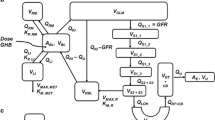Summary
The pharmacokinetics of the blood level and the patterns ofl4CO2 exhalation were determined simultaneously following i.v. administration of14C-methacetin to the conscious rat. The pattern of exhalation ofl4CO2 did not parallel the biexponential decline of radioactivity in the blood and a delay of 30–40 min preceeded the maximal rate ofl4CO2 exhalation. The total radioactivity exhaled remained constant at 56±4.5% (SD) of the applied dose throughout a tenfold dose range of methacetin (0.6, 4.0 and 6.0 mg/kg i.p.), administered to groups of three rats each and measured over a period of 4 hours. The pattern of radiolabel exhalation was biexponential with the low dose, linear with the medium dose and convex with the high dose. Although the total fraction of the label expired after 4 hours remained constant, the rates of exhalation at the higher dosages exhibited saturation type kinetics. At the higher dosage, since the pattern of14CO2 exhalation did not accurately reflect the decline of methacetin seen in blood, one of the steps occuring between the demethylation process and the production of expired CO2 appears to be rate limiting.
Significant increases in the amount ofl4CO2 exhaled within 1 hour were obtained by pretreatment with phenobarbital, rifampicin and 3-methylcholanthrene. Again the proportion of radiolabel expired in 4 hours remained constant.
Acute hepatic injury produced by pretreatment with graded doses of carbon tetrachloride resulted in graded reductions in the amount of14CO2 exhaled in the first hour, although the total amount exhaled during the 4 hour collection period did not change. This resulted from a reduction in the maximal exhalation rate and a prolongation of the overall elimination process.
It is concluded that the determination of the maximal exhalation rate and of cumulative exhalation within one hour provides useful measures ofl4C-methacetin demethylation capacity. This is also true for conditions of extensive liver damage where terminal exhalation rates cannot easily be determined.
Similar content being viewed by others
References
Fromm H., Thomas P.J., Hofmann A.F. (1973): Sensitivity and specificity in tests of distal ileal function: Prospective comparison of bile acid and vitamin B12 absorption in ileal resection patients. Gastroenterology, 64: 1077–1090.
Kaihara S., Wagner jr. H.S. (1968): Measurement of intestinal fat absorption with carbon-14 labeled tracers. J. Lab. Clin. Med.,71, 400–411.
Hepner G.W., Vessel E.S. (1974): Assessment of aminopyrine metabolism in man by breath analysis after oral administration ofl4C-aminopyrine: Effects of phenobarbital, disulfiram and portal cirrhosis. N. Eng. J. Med.,291, 1384–1388.
Hepner G.W., Vesell E.S. (1975): Quantitative assessment of hepatic function by breath analysis after oral administration ofl4C-aminopyrine. Ann. Int. Med.,83, 632–638.
Hepner G.W., Vessel E.S. (1976): Aminopyrine disposition: Studies on breath, saliva and urine of normal subjects and patients with liver diseases. Clin. Pharmacol. Ther.,20, 654–660.
Lauterburg B.H., Bircher J. (1976): Expiratory measurement of maximal aminopyrine demethylationin vivo. Effect of phenoarbital, partial hepatectomy, portacaval shunt and bile duct ligation in the rat. J. Pharmacol. Exp. Ther.,196, 501–509.
Schneider J.F., Schoeller D.A., Nemchausky B., Boyer J.L., Klein P. (1978): Validation of13CO2 breath analysis as a measurement of demethylation of stable isotope labeled aminopyrine in man. Clin. Chim. Acta,84, 153–162.
Platzer R., Galeazzi R.L., Karlaganis G., Bircher J. (1978): Rate of drug metabolism in man measured byl4CO2 breath analysis. Europ. J. Clin. Pharmacol.,14, 293–299.
Desmond P.V., Branch A., Calder I., Schenker S. (1980): Comparison of [l4C] phenacetin and amino [l4C] pyrine breath test after acute and chronic liver injury in the rat. Proc. Soc. Exp. Biol. Med.,164, 173–177.
Leferink J.G., Maes R.A.A. (1979): STRIPACT, an interactive curve fit programme for pharmacokinetic analyses. Arzneimittelforsch,29, 1894–1898.
Houston J.B., Lockwood G.F., Taylor G. (1981): Aminopyrine demethylation kinetics. Use of metabolite exhalation rates as an index of enhanced mixed-function oxidasein vivo. Drug. Metab. Dispos.,9, 449–455.
Wagner J.G. (1963): Some possible errors in the plotting and interpretation of semilogarithmic blood level and urinary excretion data. J. Pharm. Sci.,82, 1097–1101.
Thornhill D.P., Field S.P. (1982): Distribution of lithium elimination rate in a selected population of psychiatric patients. Europ. J. Clin. Pharmacol.,21, 351–354.
Gikalov I., Bircher J. (1977): Dose dependence of thel4C-aminopyrine breath test. Intrasubject comparison of tracer and pharmacological doses. Europ. J. Clin. Pharmacol.,12, 229–233.
Waydhas C., Weigl K., Sies H. (1978): The disposition of formaldehyde and formate arising from drug N-demethylations dependent on cytochrome P-450 in hepatocytes and in perfused rat liver. Europ. J. Biochem.,89, 143–150.
Raaflaub J., Dubach U.C. (1975): On the pharmacokinetic of phenacetin in man. Europ. J. Clin. Phamacol.,8, 261–265.
Roots I., Nigam S., Gramatzki S., Heinemeyer G., Hildebrandt A.G. (1980): Hybrid information provided by the14C-aminopyrine breath test. Studies withl4C-monomethylaminoantipyrine in the guinea pig Naunyn-Schmiedeberg’s. Arch. Pharmacol.,313, 175–178.
Gescher A., Raymont C. (1981): Studies of the metabolism of N-methyl containing anti-tumor agents. Biochem. Pharmacol.,30, 1245–1252.
Kato R., Kamataki T. (1982): Cytochrome P-450 as a determinant of sex difference of drug metabolism in the rat. Xenobiotica,12, 787–800.
Rhodes J.C., Houston J.B. (1983): Antipyrine metabolite kinetics in phenobarbital and β-naphthoflavone-induced rats. Drug Metab. Dispos.,11, 131–136.
Breyer-Pfaff U., Harder M., Egberts E.H. (1982): Plasma levels of parent drug and metabolites in the intravenous aminopyrine breath test. Europ. J. Clin. Phamacol.,21, 521–528.
Author information
Authors and Affiliations
Rights and permissions
About this article
Cite this article
Thornhill, D.P., Steffen, C. & Netter, K.J. A kinetic evaluation of14CO2 in expired air after14C-methacetin administration in rats, used for thein vivo study of the metabolism of drugs. European Journal of Drug Metabolism and Pharmacokinetics 9, 161–168 (1984). https://doi.org/10.1007/BF03189620
Received:
Issue Date:
DOI: https://doi.org/10.1007/BF03189620




